SUBHEAD: Experiments with breadfruit - with results ranging from appetizer, to staple to dessert.
By Juan Wilson on 15 November 2009 for Island Breath -
(http://islandbreath.blogspot.com/2009/11/breadfruit-recipe-experiments.html)
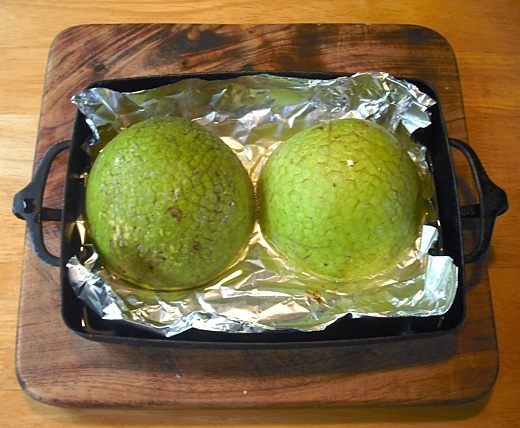 Image above: Breadfruit prepared for baking at 375F for one hour in oven.
Image above: Breadfruit prepared for baking at 375F for one hour in oven.
This autumn a breadfruit tree on our road bore a lot of fruit. The property the tree is on has been unoccupied and the breadfruit has been falling onto the street and rotting. We decided to pick a few off the tree and experiment with some recipes. We used an extending fruit picker to gather them them.
I do not know the specific variety of the breadfruit. They are spherical medium sized (about 7" in diameter) with small seeds and smooth flesh.
When the fruit is fully ripe it is easy to pull from the tree. Note that breadfruit stems are thick and tough. When ripe it is not difficult to pull the stem and inner nut core out of the fruit. But some uses of breadfruit require greener fruit. These can be quite tough to pull off the tree. Besides the variety, the ripeness is the most important factor in the flavor and texture of the breadfruit recipe results.
Our experience is that breadfruit, unless green, has a short shelf life. Ripe fruit needs to be used immediately. Ripe and cooked breadfruit seem best consumed when prepared.
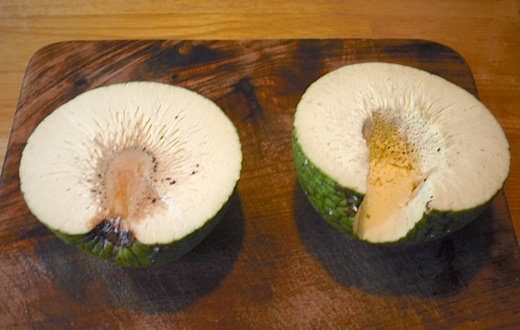 Image above: Raw greenish breadfruit cleaned, split and cored.
Image above: Raw greenish breadfruit cleaned, split and cored.
Our first experiment was with two breadfruit. One was slightly green, and the other slightly ripe. Note, most of the whitish stains on the fruit was dried latex from the fruit and not bird guano. In any case, we washed the breadfruit before we cut them in half and cored them.
If there is sticky latex on the fruit, it helps to submerge in water while cutting. We then put them in a pan on aluminum foil in about a half inch of water and baked them for one hour at 375F. The results were quite different with the two fruit. The slightly green breadfruit was still firm after baking.
We sliced it laterally and skinned it. We noticed a distinct flavor of artichoke heart, and used it as such in an appetizer. It could be served cool with a mayonnaise and lemon dressing, or warm with a melted butter dipping sauce. The slightly ripe breadfruit was the consistency of potato and we scooped it out into a bowl.
It had a yellowish (and in places pinkish) tint. It proved to have a delicate slightly sweet and starchy taste that could be served in place of a yam or sweet potato either as a side dish or staple.
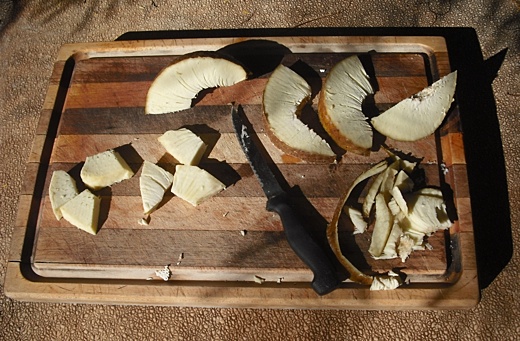 Image above: A baked green breadfruit skinned and being cut for the frying pan.
Image above: A baked green breadfruit skinned and being cut for the frying pan.
Our second excursion to the bread fruit tree yielded a green and a ripe breadfruit that we used with quite different results. The green breadfruit we again split, cored and baked at 375 for and hour in a half inch of water. The result was as firm as the "artichoke" breadfruit but had a potato starchiness. We skinned and made large diced sections (3/4"). We heated olive oil in an iron skillet with fresh-cut garlic and salt. We then fried the breadfruit in the oil and garlic and slightly browned them. The result was a like a fried potato side dish that could even be used as an appetizer.
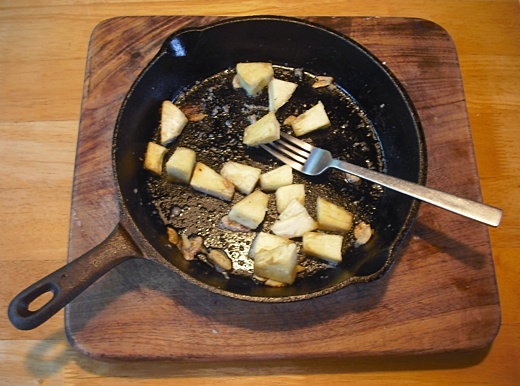 Image above: Pan fried breadfruit and garlic, seasoned with sea salt.
Image above: Pan fried breadfruit and garlic, seasoned with sea salt.
Our final experiment was with a fully ripe breadfruit. It had come off the tree easily, leaving its stem and core aloft. It was so sweet that a few ants had discovered it. We submerged and cleaned the fruit gently in a bowl of water. We drained it and scraped all the seeds and textured parts of the fruit off with a large spoon. The fruit then had a smooth consistency and soft texture, similar to ice cream. A sample taste inspired an idea.
 Image above: Ripe sweet breadfruit after washing and clearing core.
Image above: Ripe sweet breadfruit after washing and clearing core.
We scooped out some of the flesh into a bowl, drizzled it with chocolate and put it in the freezer. Later, after it had frozen firm, we took it out, let it warm slightly at room temperature and tried it as a dessert. It was great! Tasted almost like peach ice cream to me. A caution, however, for those sensitive to latex. We think sap of the raw breadfruit gave my wife a small itchy reaction in her throat. I had no reaction.
We have similar responses to fried Chinese variety taro. I love it, my wife has a bit of an itch from it. After trying for breadfruit in a short time from the same tree I have concluded that breadfruit has a wide range of textures and flavors that are hard to anticipate with any one fruit. One can "wing it" and create many different results that can surprise and delight.
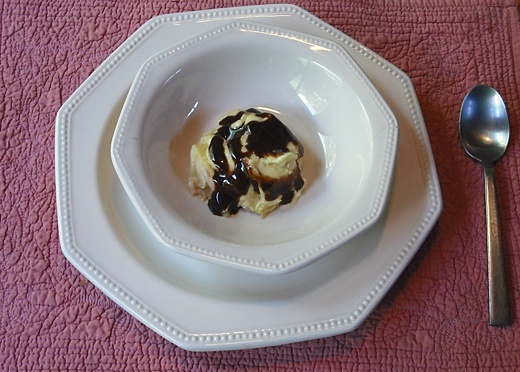
Image above: Breadfruit ice cream with drizzle of chocolate ready to eat.
See also:
Ea O Ka Aina: Get out your `Ulu! 7/19/09
Island Breath: Ulu - The Breadfruit Tree 12/31/06
Ea O Ka Aina: Peak Macadamia Nut 9/22/09
Ea O Ka Aina: Green Turtle Mango 10/13/09
Ea O Ka Aina: Green Papaya Sauerkraut 10/14/09
By Juan Wilson on 15 November 2009 for Island Breath -
(http://islandbreath.blogspot.com/2009/11/breadfruit-recipe-experiments.html)
 Image above: Breadfruit prepared for baking at 375F for one hour in oven.
Image above: Breadfruit prepared for baking at 375F for one hour in oven.This autumn a breadfruit tree on our road bore a lot of fruit. The property the tree is on has been unoccupied and the breadfruit has been falling onto the street and rotting. We decided to pick a few off the tree and experiment with some recipes. We used an extending fruit picker to gather them them.
I do not know the specific variety of the breadfruit. They are spherical medium sized (about 7" in diameter) with small seeds and smooth flesh.
When the fruit is fully ripe it is easy to pull from the tree. Note that breadfruit stems are thick and tough. When ripe it is not difficult to pull the stem and inner nut core out of the fruit. But some uses of breadfruit require greener fruit. These can be quite tough to pull off the tree. Besides the variety, the ripeness is the most important factor in the flavor and texture of the breadfruit recipe results.
Our experience is that breadfruit, unless green, has a short shelf life. Ripe fruit needs to be used immediately. Ripe and cooked breadfruit seem best consumed when prepared.
 Image above: Raw greenish breadfruit cleaned, split and cored.
Image above: Raw greenish breadfruit cleaned, split and cored.Our first experiment was with two breadfruit. One was slightly green, and the other slightly ripe. Note, most of the whitish stains on the fruit was dried latex from the fruit and not bird guano. In any case, we washed the breadfruit before we cut them in half and cored them.
If there is sticky latex on the fruit, it helps to submerge in water while cutting. We then put them in a pan on aluminum foil in about a half inch of water and baked them for one hour at 375F. The results were quite different with the two fruit. The slightly green breadfruit was still firm after baking.
We sliced it laterally and skinned it. We noticed a distinct flavor of artichoke heart, and used it as such in an appetizer. It could be served cool with a mayonnaise and lemon dressing, or warm with a melted butter dipping sauce. The slightly ripe breadfruit was the consistency of potato and we scooped it out into a bowl.
It had a yellowish (and in places pinkish) tint. It proved to have a delicate slightly sweet and starchy taste that could be served in place of a yam or sweet potato either as a side dish or staple.
 Image above: A baked green breadfruit skinned and being cut for the frying pan.
Image above: A baked green breadfruit skinned and being cut for the frying pan.Our second excursion to the bread fruit tree yielded a green and a ripe breadfruit that we used with quite different results. The green breadfruit we again split, cored and baked at 375 for and hour in a half inch of water. The result was as firm as the "artichoke" breadfruit but had a potato starchiness. We skinned and made large diced sections (3/4"). We heated olive oil in an iron skillet with fresh-cut garlic and salt. We then fried the breadfruit in the oil and garlic and slightly browned them. The result was a like a fried potato side dish that could even be used as an appetizer.
 Image above: Pan fried breadfruit and garlic, seasoned with sea salt.
Image above: Pan fried breadfruit and garlic, seasoned with sea salt.Our final experiment was with a fully ripe breadfruit. It had come off the tree easily, leaving its stem and core aloft. It was so sweet that a few ants had discovered it. We submerged and cleaned the fruit gently in a bowl of water. We drained it and scraped all the seeds and textured parts of the fruit off with a large spoon. The fruit then had a smooth consistency and soft texture, similar to ice cream. A sample taste inspired an idea.
 Image above: Ripe sweet breadfruit after washing and clearing core.
Image above: Ripe sweet breadfruit after washing and clearing core.We scooped out some of the flesh into a bowl, drizzled it with chocolate and put it in the freezer. Later, after it had frozen firm, we took it out, let it warm slightly at room temperature and tried it as a dessert. It was great! Tasted almost like peach ice cream to me. A caution, however, for those sensitive to latex. We think sap of the raw breadfruit gave my wife a small itchy reaction in her throat. I had no reaction.
We have similar responses to fried Chinese variety taro. I love it, my wife has a bit of an itch from it. After trying for breadfruit in a short time from the same tree I have concluded that breadfruit has a wide range of textures and flavors that are hard to anticipate with any one fruit. One can "wing it" and create many different results that can surprise and delight.

Image above: Breadfruit ice cream with drizzle of chocolate ready to eat.
See also:
Ea O Ka Aina: Get out your `Ulu! 7/19/09
Island Breath: Ulu - The Breadfruit Tree 12/31/06
Ea O Ka Aina: Peak Macadamia Nut 9/22/09
Ea O Ka Aina: Green Turtle Mango 10/13/09
Ea O Ka Aina: Green Papaya Sauerkraut 10/14/09
6 comments :
What a delightful, and valuable report on using local breadfruit!
In Fiji, traditionally, men go off for daily work & on their way home, climb breadfruit trees to harvest fruit with their machetes, and bring them home for their wives to cook for dinner.
I feel that planting breadfruit trees along roads and on public lands throughout Hawaii, would be one of the most simple but efficient steps we could take to start establishing food security for Hawaii's future.
Clearly, though, the first step is to get used to eating and enjoying breadfruit, which you are inspiring here with this report of your experiments.
(Julia Morton's "Fruits of Warm Climates", available to read online, has much detail of traditional uses of breadfruit, and most other fruits.)
So, once again Juan, thank you for your excellent contribution.
Warm regards, Jenny in Wailua
Juan, super article. Do you know of anywhere that propogates breadfruit starts? I've asked all over - NTBG and every nursery I can think of. If you do or if anyone reading the comments does, please post a comment with the details. Mahalo, Noel
Propagation
The seeded breadfruit is always grown from seeds, which must be planted when fairly fresh as they lose viability in a few weeks. The seedless breadfruit is often propagated by transplanting suckers which spring up naturally from the roots. One can deliberately induce suckers by uncovering and injuring a root. Pruning the parent tree will increase the number of suckers, and root pruning each sucker several times over a period of months before taking it up will contribute to its survival when transplanted. For multiplication in quantity, it is better to make root cuttings about 1 to 2 1/2 in (2.5-6.35 cm) thick and 9 in (22 cm) long. The ends may be dipped into a solution of potassium permanganate to coagulate the latex, and the cuttings are planted close together horizontally in sand. They should be shaded and watered daily, unless it is possible to apply intermittent mist. Calluses may form in 6 weeks (though rooting time may vary from 2 to 5 months) and the cuttings are transplanted to pots, at a slant, and watered once or twice a day for several months or until the plants are 2 ft (60 cm) high. A refined method of rapid propagation uses stem cuttings taken from root shoots. In Puerto Rico, the cuttings are transplanted into plastic bags containing a mixture of soil, peat and sand, kept under mist for a week, then under 65% shade, and given liquid fertilizer and regular waterings. When the root system is well developed, they are allowed full sun until time to set out in the field.
http://www.hort.purdue.edu/newcrop/morton/breadfruit.html#Propagation
Aloha.
Ulu has been a staple of the polynesian diet for 3 millenia.
It was a staple of the peoples diet here on Kaua'i as elsewhere, and was of course, traditionally cooked in the imu. Here on Kaua'i it is still a staple in some traditional homes.
We tended to eat it with butter, and it was cooked to a very soft consistancy, hence its name in English "breadfruit". The traditional way to eat breadfruit, or "ulu" in the "Olelo vernacular is by cooking in an imu, or in a modern oven.
Ulu and Kalo (taro) are both used in stews by boiling, and can also be fried as well. The Tongans and Samoans here on Kaua'i in my opinion make the best ulu dishes.
Another thing that ulu was used for was an inferior poi eaten under the Kapu system mostly by women. Ulu poi is a beautiful yellow color. and was very common to be eaten before, but was considered an inferior poi and was never ussually eaten by men or by the ali'i. However during times of famine it may have been consumed by all memebrs of society. Poi was also made using u'ala (sweet potato/yam) as well.
The leaves of the ulu tree can also be used as a medicine when steeped and boiled into a tea, and the leaves were also used as an adornment on hula altars, and sometimes even for hula attire.
Ulu was a staple offering to the gods and godesses especially the god Lono and other gods and godesses of whom it was associated.
Ulu starts were brought to the archipilego of Hawai'i as one of the traditional 13 canoe plants, and there are several common varieties here, generally known as "Tahitian" and "Samoan" varieties, in the same way we also commonly refer to niu (coconut) as either "Tahitian" or "Samoan" varieties.
In reality, breadfruit or ulu comes from Cook Islands, Fiji, Micronesia, French Polynesia, Guam, Kiribati, Mariana Islands, Palau, Papua New Guinea, Rotuma, Samoa, Soloman Islands, Tokelau, Tonga, Vanuatu, and also is found in the Phillipines, Seychelles and Honoduras.
The NTBG houses the largest collection of ulu in the world, and has species that are no longer found in their places of origin with over 120 varieties of the three main varities of ulu, from approximately 34 islands.
Check the NTBG site here, for more on the Breadfruit Institute, and see how Hawaii is doing its part to protect and preserve this most important food of the people of the Pacific, which is still one of the most important part of many peoples diets throughout Polynesia, Micronesia and Melanesia.
www.http://ntbg.org/breadfruit/mission.php
keep on cookin !
sincerely and with aloha
Anne Punohu
Kalaheo, HI
Hello,
I am writing an ebook about Jamaican food and just realised that I don't have a picture showing my customers what a "breadfruit heart! is. And so I was wondering if I could use the picture on your site, with your permission of course. I will also cite your webpage in my ebook.
Kind regards,
Email: mycrazyjamaican@gmail.com
http://mycrazyjamaican.webs.com/
Aloha
One misconception...poi made from ulu was not "inferior". The best poi is a mixture of ulu and kalo, which was prepared for the ali'i.
As for recipes:
- cut the green ulu like french fries... throw in some olive oil, salt... and bake at 400 for about 25 minutes...or until golden brown. It gets a crunchy exterior, and soft interior...the perfect french fry (or should be call it "hula fries")
- this is from my puerto rican grandmother...cut the green ulu in cubes of about 1"x1"x1"....fry them....until golden....remove them. Now this is the tricky part... between two flat surfaces, squeeze them...making like an irregular broken pancake....then re-fry them....until crispy. She called these "tostones de panapen"....they are awesome with spycy sauce, and salt.
Mahalo....
Kuana
Post a Comment